I am not sure about how the crystal oscillators are made. Some say it has a crystal but some says it has an LC combination which requires a parallel capacitor to resonate with the internal LC combination.What is the actual construction.
-
2There's a big difference between a "crystal" that is used in an "oscillator" and, a "crystal oscillator". You appear to be confusing the two things. The construction of a crystal is a subset of the construction of a crystal oscillator. Internally, it may be of some interest to some folk what a crystal is but, for EEs they are mainly interested in a circuit that oscillates using a crystal. – Andy aka May 09 '23 at 09:54
-
Could you please explain the difference the two and answer the question then. – kam1212 May 09 '23 at 09:55
-
2No, I can't answer a question that is ambiguous. I've done my best to give you some information so that you can fix your question and decide what you want to ask about. Please fix your question. – Andy aka May 09 '23 at 09:56
-
@Andyaka Sir kindly tell me about the crystal oscillator.What is the internal circuitry in that? – kam1212 May 09 '23 at 12:38
-
Muhammad, unlike other sites that are like forums, you must ask unambiguous questions in the area reserved for questions (above). So, you have now asked about crystal oscillators (in your recent most comment) and, normally I would encourage you to make your formal question clear about that. However, there are two answers presented in the last 10 minutes that interpret your formal question differently hence, I cannot answer and you cannot refocus your ambiguous question without causing consternation to the guys who have answered.... – Andy aka May 09 '23 at 13:11
-
1...Nevertheless, they should have noted my comments above and anticipated that you might refocus your question to make it right for me to answer. It's up to you. – Andy aka May 09 '23 at 13:12
3 Answers
A crystal oscillator has two things : the oscillator circuitry meant to be connected to a crystal, and the crystal itself.
The crystal is a suitably cut and polished piece of quartz crystal.
There are no LC circuits in it, but it can be modeled as such.
Crystals do need load capacitors of correct value to make the crystal oscilator to oscillate at the correct rate.
- 127,425
- 3
- 97
- 261
-
Why do we need an LC stuff if the crystal could oscillate on its own. Why do we need to attach two capacitors to a crystal if there is already an oscillation produced? – kam1212 May 09 '23 at 13:09
-
I don't understand why you say we need LC stuff because we don't need LC stuff, except for overtone crystals. If you want to analyze the oscillation mathematically, then you use LC equivalent of the crystal parameters. And you don't need the capacitors if the crystal is for series oscillation. The crystal is manufactured so that it runs at rated frequency when it has the rated load capacitance. It may oscillate without correct capacitors but it will then oscillate at wrong speed, kind of like an LC oscillator will run at wrong frequency if you have the wrong C. – Justme May 09 '23 at 13:14
-
Okk so it means the capacitors are just to help the crystal oscillate in with the correct frequency. Its to improve the oscillations. Some diagrams used LC configution for the crystal that's why I was confused – kam1212 May 09 '23 at 13:28
I am not sure about how the crystal oscillators are made.
A representation of a crystal below.
This piezoelectric crystal is mounted inside a protective case. Its two electrodes are brought from its casing to two terminals:

To make an oscillator, its two terminals must be excited at one of its mechanically-resonant frequencies.
You can think of a crystal two ways:
- It is a mechanically-resonant device that goes "pinggggggg...." when disturbed.
- It is electrically active (between its two electrodes) when mechanically in motion
The translation between electrical and mechanical operation is via its piezo-electric properties. An oscillator circuit provides an alternating current to excite the crystal electrically at one of its mechanically resonant frequencies.
From an electrical point-of-view, a crystal can be represented by three discrete electrical components: a resistor, an inductor and a capacitor. A crystal's dimensions (thickness, area, plating) determine the electrical values of resistance, inductance, capacitance. In both mechanical and electrical realms, this device can be called a resonator.
- 23,591
- 1
- 22
- 50
-
1To make an oscillator, the crystal must be excited at a frequency that produces the right phase shift and, this won't be at a mechanical resonance but slightly askew from series mechanical resonance when connected to loading capacitors. – Andy aka May 09 '23 at 13:17
The capacitor(s) slightly change the resonant frequency.
For a circuit to oscillate, it is necessary to have 180 ° phase shift after the inverter. If the inverter (or transistor) doesn't have precisely 180 °, then the feedback network (crystal) may need to be slightly different from 180 ° -- say 181 or 179 °. The capacitors help achieve this be changing the resonance from series resonant (modeled as the equivalent L & C_int in series) to parallel resonant (where the external C_ext is in series with the internal C, making the effective C slightly lower.
Is C_ext is >> C_int, the change in frequency is small (equivalent to saying the change in phase with frequency is very sharp), so whatever phase shift the inverter needs can be reached with a final frequency that is very close to the native L.C_int resonant frequency. Consequently, the frequency stability is high and only very slightly dependent on the inverter's or C_ext's precise characteristics.
- 18,395
- 17
- 46